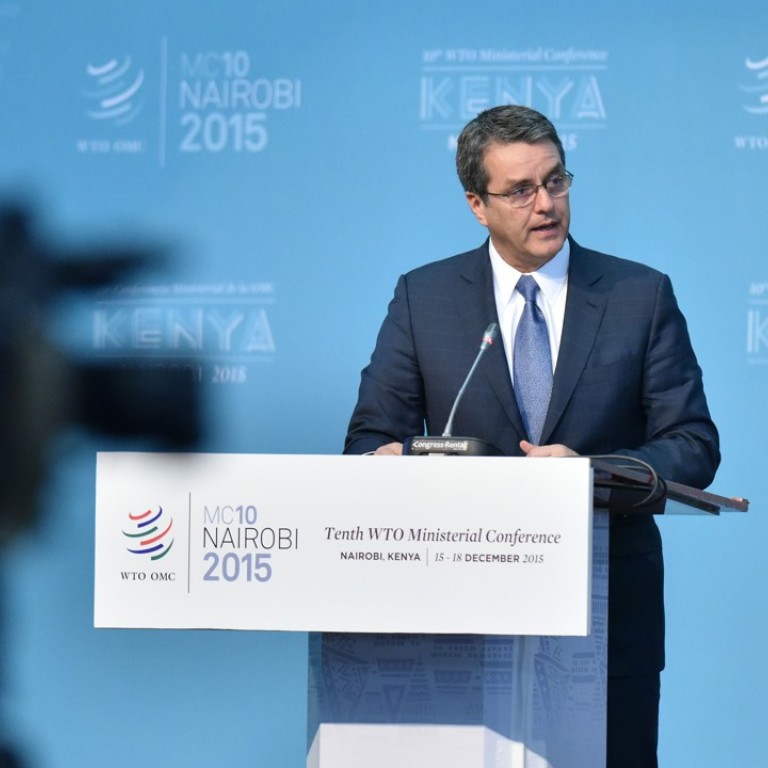
China tech prices to plummet on 201 goods in US$1.3tn 11th hour tariff deal dubbed ‘rollercoaster ride’
About 65 per cent of tariffs on covered products will be fully eliminated by July 1 next year, with almost all scheduled to be duty-free by 2019
The United States, China and 51 other economies have wrapped up a landmark deal to remove annual tariffs worth US$1.3 trillion on 201 information and communications technology products around the world from July 1 next year.
The years-long effort to expand the scope of the Information Technology Agreement (ITA), a global tariff-cutting pact initiated in 1996, was completed on Wednesday at the 10th World Trade Organisation (WTO)Ministerial Conference in the Kenyan capital of Nairobi after negotiators approved certain last-minute demands by China.
It was long past due to update the ITA. The technology we use everyday has evolved significantly since 1996
“Eliminating tariffs on trade of this magnitude will have a huge impact,” WTO Director-General Roberto Azevedo said.
He pointed out that the deal will help boost gross domestic product growth around the world, create jobs and support lower prices, including in many other sectors that use information technology products as components.
The expanded ITA covers such products as video game consoles, loudspeakers, video cameras, solid state drives, touch-screen displays, telecommunications satellites, Global Positioning System navigation devices, touch-screen displays, magnetic resonance imaging machines and next-generation chips, known as multi-component semiconductors.
“It was long past due to update the ITA. The technology we use everyday has evolved significantly since 1996,” said Stephen Ezell, the vice-president for global innovation policy at US think tank the Information Technology and Innovation Foundation.
Months of talks leading to the WTO meeting, however, were fraught with uncertainty as China, the world’s biggest exporter and importer of hi-tech goods, declined to pare down the number of products that it wants to keep tariffs on for an extended period.
READ MORE: China ‘has not budged an inch’: Beijing urged to make changes to global tariff-cut deal on ICT products ahead of WTO meet
“This week has been a bit of rollercoaster ride as negotiators waited for China to submit its revised tariff schedule for formal approval by all the other parties to the negotiations,” John Neuffer, the president and chief executive of the Semiconductor Industry Association, told the South China Morning Post.
Neuffer, who was in Nairobi to monitor the ITA talks, said Beijing made its submission Wednesday afternoon without any concession.
“China’s revised schedule only reflected technical fixes and not any improvements to its tariff phase-outs,” Neuffer said.
This week has been a bit of rollercoaster ride as negotiators waited for China to submit its revised tariff schedule for formal approval
The final stumbling block was China’s last-minute demand to include some additional text in the ministers’ declaration announcing the agreement on phasing out tariffs and achieving the “critical mass” of negotiating parties for the expanded ITA agreement to be in force.
“When the negotiating parties agreed on Wednesday afternoon to insert text in the declaration to capture this idea, the deal was done,” Neuffer said.
As a result of negotiations, about 65 per cent of tariffs on the covered products will be fully eliminated by July 1. Most of the remaining tariffs will be phased out in four stages over three years. This means that by 2019 almost all imports of the relevant products will be duty free.
Initiatives to expand the ITA kicked off with a major WTO conference in Geneva in May 2012.
Azevedo pointed out that all 162 WTO members will benefit from the expanded tariff-cutting pact under the “most-favoured nation principle”.
“This means that all members can export these 201 products duty-free to each of these [53 ITA participants’] markets,” Azevedo said.

